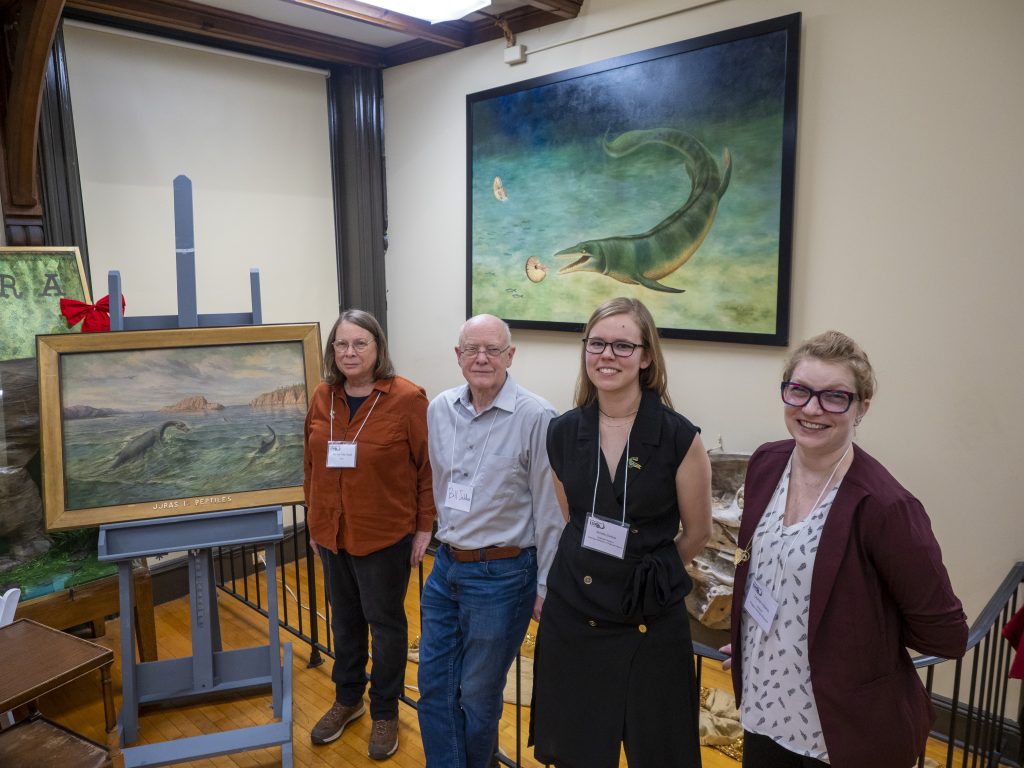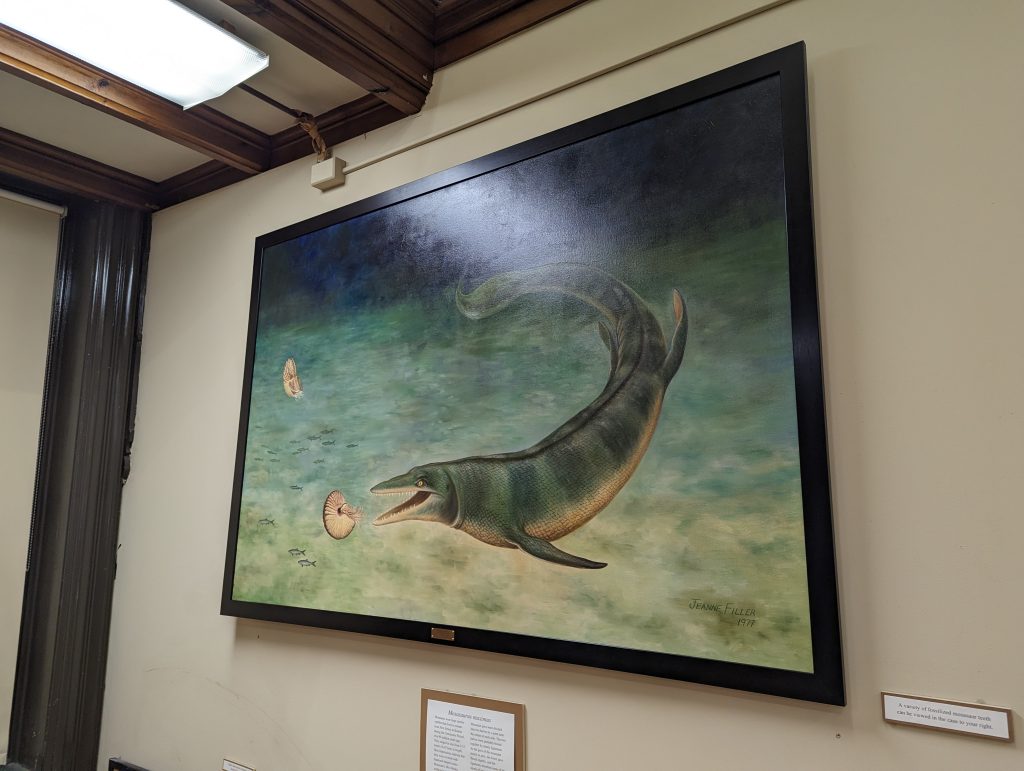By Carol Peters, EOAS Communications
At the 150th anniversary of the Rutgers Geology Museum, Mosasaurs, giant lizards who lived at the time of the dinosaurs, were explored and celebrated.

From Left to Right: Artist Jeanne Filler Scott, Former Geology Museum Director Bill Selden, Graduate Student Amelia Zietlow from the American Museum of Natural History, and Current Geology Museum Director Lauren Adamo
Mosasaurs were enormous lizards and apex predators who ruled the Earth’s waters at the time of the dinosaurs, at the very end of the cretaceous period ~95-66 million years ago. The same asteroid that blasted the dinosaurs into extinction also ended the reign of Mosasaurs. However, they live on in the fossils they left, and their remains are providing scientists with a key means of understanding evolutionary processes.
What stories do Mosasaur fossils tell? What were these giant, terrifying, sea faring creatures like? At a celebration held in honor of the 150th anniversary of the Rutgers Geology Museum, Amelia Zietlow, a Ph.D. candidate at Richard Gilder Graduate School at the American Museum of Natural History in New York City, described her research exploring Mosasaurs in her lecture, “When Serpents Encircled the Earth.”
In addition to Zietlow’s presentation, the event also celebrated Mosasaurs by hosting the unveiling of a Mosasaur painting housed at the museum. Originally painted by Rutgers alumna Jeanne Filler Scott, ’77, Scott recently restored it and was present for its unveiling.

Zietlow, who studies mosasaur growth and evolution, described mosasaurs as, “the world’s lizards.” She said, “Their fossils have been found on every continent, including Antarctica, in both salt and freshwater environments. They were crossing the Atlantic Ocean just like today’s aquatic predatory animals such as great white sharks. They were apex predators, top of the food chain in whatever environments they found themselves in. Their teeth and/or stomach contents show they were eating anything and everything that came near them. We also know they were not kind animals. In every other animal that lived at the time we find Mosasaur bite marks, including on the fossils of other Mosasaurs.”
While there is a great deal of variety among species of Mosasaurs, Zietlow said, scientists know they all descended from a species of land-living lizard with legs that evolved adaptations to enable it to live in the water. Once adapted to the water, Mosasaurs never left it (females even gave live birth in the water).
Zietlow said a major outstanding question for Mosasaur researchers is, “How many times did the lizard ancestor evolve into Mosasaurs?”
“There are three primary branches/groups/kinds of Mosasaurs,” she said, “and the question is: Did these three groups evolve from a single ancestor that evolved fins and then diversified into different mosasaurs or were there a bunch of leggy things that all separately or independently evolved flippers and tail flukes and massive size and everything else — which wouldn’t be entirely out of character as a thing for lizards to do.”
The question Mosasaurs help scientists think about in a broader context, Zietlow said, is how animals evolved to be aquatic. Mosasaurs evolved from living on the land to living in the water, but she said they weren’t the only creatures to evolve this way. Whales, crocodiles, sloths, and seals also did. She said if scientists can understand this evolutionary process in Mosasaurs, they can compare it to how this transition happened more broadly with other kinds of animals to better understand evolution.
Questions about this transition that scientists are currently asking, she said, are, did the transition from land to water happen the same way every time?” Did creatures go through the same sequence of changes in the same order or were there differences?
Zietlow said there are three main reasons she chose to study Mosasaurs: there were a lot of them; they have close living relatives; and they were “charismatic.”
“I’ve studied at least 70 Tylosaurus, which is a type of Mosasaur,” Zietlow said. “That’s 70 individuals that belonged to a single species, and there are at least another 100 Tylosaurus I have not seen. By contrast, there are only 20 T Rex known on the entire planet. When we have evolutionary questions, we need to have a significant sample size, which most dinosaurs don’t have, but Mosasaurs do.”
That they have close living relatives also makes understanding them easier, she said. “Something like T Rex we have no living analog to that – there is nothing alive today that comes anywhere close to what that animal was doing, whereas a Mosasaur was a big lizard anatomically not that far removed from its living relatives – monitor lizards. In terms of making comparisons and understanding these big picture evolutionary questions, this makes it so much easier.”
Explaining why their nature, which she describes as “charismatic” interests her, Zietlow said, “What this means is they are very cool, very interesting to work on, and very good for getting people into science and excited about biology and paleontology and evolution. Because how can you look at that Mosasaur face and not fall in love with it, and want to know everything about it, and most of importantly, how it came to be?”
Watch the full event below:



